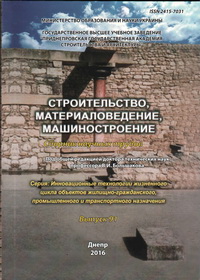Influence of vapour permeability of internal and outward plaster on warmly moisture balance of wall from autoclave aerated concrete
Keywords:
energy-savings, AAC, wall constructions, clout coverages, warmly moisture balance of wallAbstract
Annotation. Purpose.One of variants of decision of problems of energy saving, for Ukraine, there is erection of new buildings and buildings from an autoclave aerated concrete. This material possesses heat conductivity coefficient comparable with heat-insulation materials, here being construction and heat insulation, that allows to erect the both self-supported and bearings walls from him. At the thickness of a wall construction 0,4-0,5 m, normative thermal resistance is provided for any region of Ukraine, while, for example, from a brick ceramic hollow a thickness must make 1,4-1,8 m. However much the wrong choice of decorative-protective coverage, and in particular clout, levels heat-insulation and constructive properties of such constructions, diminishes longevity of buildings and buildings. It is therefore necessary to probe influence of properties, and in particular, vapour permeability, internal and outward plaster on warmly moisture conditions balance of a wall construction and to give recommendations on their application. Methodology.Results are got by the calculation of presence and size of area of condensation, through the special programs intended for the calculation of warmly moisture conditions balance of wall construction, on the basis of experimental and literary information of fiziko-mechanical and heating engineering descriptions of the gazobetonnoy laying and clout solutions, for the internal and outward finishing. Results.Graphic dependences of influence of fizikomechanical and heating engineering descriptions of clout solutions are got, for the internal and outward finishing, on a presence and size of area of condensation, in a wall construction, executed from an ААС. It is marked that on a presence and size of area of condensation has influence vapour permeability not only outward, but internal plaster. It is rotined that at presence of outward plaster with low vapour permeability, at different combinations internal, optimum warmly moisture conditions balance of a wall construction is not provided. At presence of outward plaster with high vapour permeability it is possible to provide not only the minimum area of condensation but also give that condensation of vaporous moisture can avoid in a wall construction. And it will provide optimum warmly moisture conditions balance of a wall construction, minimum heatlosses, increase of its longevity. Practical meaningfulness.Using findings, designers and builders, able correctly to appoint such clout solutions for the outward and internal finishing, that will provide optimum warmly moisture conditions balance of a wall construction, minimum heatlosses, increase of its longevity. Practical meaningfulness. Using findings, designers and builders, able correctly to appoint such clout solutions for the outward and internal finishing, that will provide optimum warmly moisture conditions of a wall construction, minimum heatlosses, increase of its longevity.References
Galkin SL, Sazhnev NP Sokolovsky LV Sazhneva NN;The use of cellular concrete products. Theory and Practice &, Minsk, 2006, 448s.
Paruta VA Features of technology of construction and exploitation is the outer walls of the AAC / Paruta VA Semin Yuri, Joiner EA Ustenko AV Brynzin EV // Building materials, equipment, 21st century technology, №12, Moscow, 2012, C. 35-39.
Sazhneva NN, NP Sazhnev, Uretskaya EA Protection-WIDE system for finishing cellular concrete in reduced density // Building materials. 2009. №1. S. 17-19.
J. Paplavskis, A.Frosh, requirements plaster compositions for exterior decoration of walls from cellular concrete. SPb .: Publishing House. Polytechnic University, 2010 S.10-15.
Rosenfeld A.G., Hafmeyster D. Energy efficient buildings // In the world of science. 1988. №6. S. 34-43
Bulgakov S.N. Energy-saving technologies brownfield reconstructed residential quarters // AVOK. 1998. №2. S. 5.
Kochegarov A.D. Improved utilities ensure its transition to a market economy // Teploenergoeffektivnye technology WI. 2002. №2. pp 11-13
D. Gibbons, P. Blair, J. Guin Energy Strategy // In the world of science. 1989. №11. C. 76-85
K. Gertis Buildings twenty-first century - the building zero-energy // Energy saving. 3.- 2007.- p. 34-36
Downloads
Published
Issue
Section
License
Редакція Видання категорично засуджує прояви плагіату в статтях та вживає всіх можливих заходів для його недопущення. Плагіат розглядається як форма порушення авторських прав і наукової етики.
При виявлені у статті більш ніж 25% запозиченого тексту без відповідних посилань та використання лапок, стаття кваліфікується як така, що містить плагіат. У цьому випадку стаття більше не розглядається редакцією, а автор отримує перше попередження.
Автори, в статтях яких повторно виявлено плагіат, не зможуть публікуватися в усіх журналах Видавництва ДВНЗ «Придніпровська державна академія будівництва та архітектури».
Автори, які публікуються у цьому журналі, погоджуються з наступними умовами:
- Автори залишають за собою право на авторство своєї роботи та передають журналу право першої публікації цієї роботи на умовах ліцензії Creative Commons Attribution License, котра дозволяє іншим особам вільно розповсюджувати опубліковану роботу з обов'язковим посиланням на авторів оригінальної роботи та першу публікацію роботи у цьому журналі.
- Автори мають право укладати самостійні додаткові угоди щодо неексклюзивного розповсюдження роботи у тому вигляді, в якому вона була опублікована цим журналом (наприклад, розміщувати роботу в електронному сховищі установи або публікувати у складі монографії), за умови збереження посилання на першу публікацію роботи у цьому журналі.
- Політика журналу дозволяє і заохочує розміщення авторами в мережі Інтернет (наприклад, у сховищах установ або на особистих веб-сайтах) рукопису роботи, як до подання цього рукопису до редакції, так і під час його редакційного опрацювання, оскільки це сприяє виникненню продуктивної наукової дискусії та позитивно позначається на оперативності та динаміці цитування опублікованої роботи (див. The Effect of Open Access).

